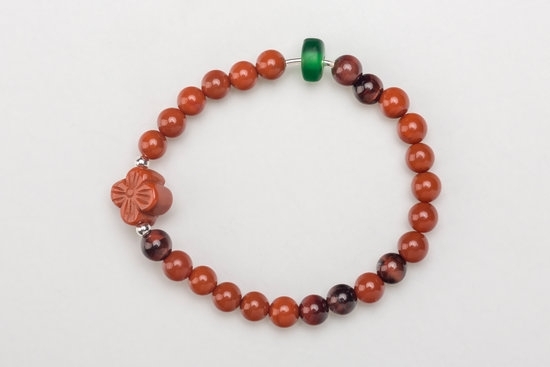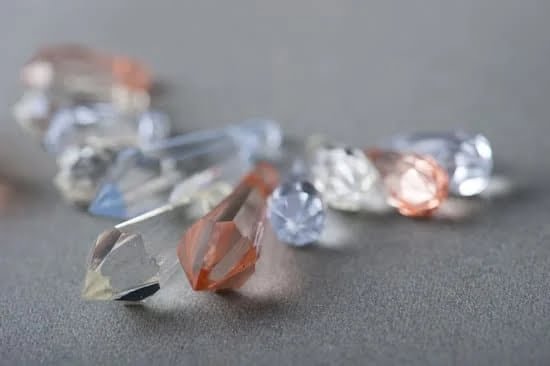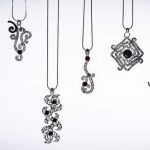The history of micro mosaic jewelry goes back centuries, with evidence pointing to artisans in Renaissance Italy as being some of the earliest practitioners of this intricate art form. Micromosaic jewelry, often known by other names such as Florentine mosaic or filigree murrina, is a type of jewelry found primarily in Italian-style metalwork. Its name refers to its concentration on small elements and incredible detail, making it a stunning work of craftsmanship.
Working with micromosaic involves creating a very fine paste from small glass cubes pressed together, which are then glued onto metal. The glass elements can be as small as 2mm, often set onto brass or gold and made into settings for gems.
Renaissance heritage: Exploring the influences that formed Micro Mosaic Jewelry
The origin story of micromosaic involves the influence of two ancient cultures – Roman and Byzantine – combined with one of Europe’s most celebrated periods: The Renaissance. Historical evidence suggests that many techniques used in today’s micromosaic were developed during the Renaissance period and beyond in Italy.
Very few written records remain about this craft before 1600AD however archaeological studies have unearthed various examples of pre-renaissance micro mosaic jewelry which date back to the 12th century CE. Much like today’s pieces, these artifacts were intricate mosaics usually affixed on brooches or rings and decorated with imagery: flora, animals, geometric shapes, religious symbols etc…
Legacy & Modern Applications Of Micro Mosaic Jewelry In Artistic Expression
Despite its age-old origins, micro mosaic jewelry continues to captivate audiences new and old alike today due its vivid aesthetic capabilities that transcend time through generations. Although mostly still used within the realm of traditional jewelry design & production; due to its versatile nature within artistic expression this type medium also has many modern applications within product design, fashion & interiors too.
For example you could find a range creative use cases from furniture texturization through lightfixture designs up top high end home decor applications such as wall paneling décor & more.
History of Micro Mosaic Jewelry
Micro mosaic jewelry has a long and rich history. Its roots go back to ancient Roman antiquity, which is when the art of using tiny glass tesserae was used to create beautiful mosaics. These works of art depicted various scenes such as battles, chariot races, religious ceremonies, and more.
They were made by hand and took many days to complete. Over time this form of art spread throughout Europe and it eventually became popularized in Italy during the Renaissance period. It was during this time that micro mosaics first began appearing in pieces of jewelry.
Venetian craftspeople from the 1500s onwards crafted intricate micro mosaic necklaces, earrings, rings and other adornments for wealthy patrons. The use of tiny glass pieces quickly became a sign of exceptional craftsmanship and status among Venetian’s upper class society. Every design included small geometric patterns and bright colors to create highly detailed images ranging from bucolic landscapes to beautiful portraits and biblical stories.
In the 19th century, the popularity of micro mosaic jewelry began to decline because it was so costly; however high quality examples still exist today and are highly sought after by collectors due to their unique beauty, rarity and detail. Many contemporary artisans have adopted this centuries-old technique with stunning results as modern methods allow them to incorporate even more detail into their pieces than ever before – giving new life to an old tradition.
Though micro mosaic jewelry may not be as common as it once was in ancient Rome or Renaissance Venice, its beauty still captures the hearts of many today – proving that its heritage truly stands the test of time.
Different Styles of Micro Mosaic Jewelry
Micro mosaics have been around for centuries, but it wasn’t until the eighteenth century that the craft became standardized and the first true micro mosaics were created. Around this time, Roman jewelers developed a specific style of intricate mosaic patterning using tiny pieces of colored glass and stone which was used to form designs.
This type of jewelry was appreciated for its exquisite craftsmanship as well as its beauty and has since remained sought after by collectors all over the world.
The alternating colors found in micro mosaic pieces are split into small tesserae, which is an Italian term for ‘mosaic tile’. These tesserae can be just a few millimeters wide, but when combined together create intricate images or decorative embellishments. This technique has become increasingly refined what is now known as a miniaturized mosaicing art form, micro mosaic or tiny mosaic jewelry.
Because of its delicate nature, micro mosaic jewelry is usually seen in rather simple, classic shapes such as crosses, flowers and complex geometric forms like stars and latticework. While preferred metal bases vary greatly between different cultures at different times, gold vermeil was most commonly used during the 18th century because it best complemented the various colors featured within these pieces.
Micro mosaic elements can also be found in other non-jewelry items such as cameo brooches and even small sculptures made from glazed ceramic tiles or stones with a variety of a beautiful colored materials used to decorate them such as semi-precious stones and glass cubes.
Today there are many variations on the traditional design; some feature hand crafted stains while others offer contemporary touches such as colorful Swarovski crystals. Due to their quality workmanship and universally timeless beauty, micro mosaic accessories continue to garner attention from discerning collectors across the globe that understand their rich history and appreciate their artistic value within jewelry making as well as smaller more diminutive works of art.
Crafting Micro Mosaic Jewelry
The art of crafting micro mosaic jewelry began in Rome during the 18th century. Made of tiny faceted glass tiles, these pieces were designed to catch the light and create mesmerizing mosaic patterns, however most crafters used them on home furnishings like tables, moldings and doors.
In time it became a craft that was exclusively found in countries like Italy, Germany and Austria. The use of micro mosaics for jewelry truly began during the 19th century as a result of people becoming more creative with their decorations and designs.
Micro mosaics involves cutting tiny glass into small square or rectangular shapes and fixing them to metal frames using inferior quality glues to form patterns. The colors used range from earthy colors such as pastel pinks, whites, blues etc., to bright colors such as greens, reds or orange shades. Micro-mosaics are very intricate since each piece of glass must be cut and placed precisely by hand.
Gold is used for the base of many of these designs due to its ability to glitter beneath the lights more powerfully than other metals would. Silvers are also used but they don’t reflect as much light usually which makes them not as popular compared to gold designs made out of silver.
Jewelers have started creating various types of appliques utilizing by inserting stones such as gemstones or faux pearls alongside with the glass pieces on their metallic frame works such as necklaces, earrings and bracelets , allowing them become so fashionable around Europe once again. Special tools are required while working on those metal frames in order to carve groves on them specifically designed for each piece within that pattern.
What an amazingly stunning craft which needs endless amounts of patience , strength and laser precise movements from its artisan.
Micro Mosaic Jewelry Around the World
Micro mosaic jewelry has been around for centuries and continues to be popular today. Micro mosaics are intricate works of art made up of tiny pieces of tile that have been placed together to create an overall image. The artist will typically place the pieces onto a black or white surface, often times glueing them in place so it can hold its shape.
The origins of this type of jewelry dates back thousands of years ago and it is believed that the ancient Egyptians were the first to utilize this technique to adorn their necklaces and other jewelry designs. In Europe during the 18th century, micro mosaics began to become popular as a way to add extra detail and design to luxury accessories such as watches, rings and brooches.
This same trend quickly spread throughout the world, with many countries beginning to manufacture these delicate pieces of jewelry on a large scale.
Today, micro mosaics remain very popular in Italy where they continue to produce these fine artworks. They also remain prominent in many other parts of Europe such as Paris, where many luxury jewellers are still creating breathtaking micro mosaics for various occasions. Micro mosaic jewelry holds cultural significance for many people all over the world; its intricacies have helped define civilizations since time immemorial and its designs have transcended across generations untouched by time itself.
As technology grows more advanced everyday, microscopic technologies such as nanotechnology are being used in micro mosaic jewelry production which has allowed for even more intricate details than ever before. In addition to technology advancements, modern research has also revealed much about the techniques that were used by ancient Greeks and Romans – providing insight into why these types of unique pieces have made a lasting impression on society in so many ways over the years.
Famous Designers and Artisans Who’ve Worked with Micro Mosaic Jewelry
Micro Mosaic jewelry has been around for centuries, but it’s gained in popularity due to its intricate designs and intricate craftsmanship. Micro mosaic pieces are usually made from small tesserae, which is a glass or stone tile of a certain shape and color.
Each tile is hand placed with intense precision alongside other tiles in order to create mesmerizing patterns and images in art. Small bore drills and tweezers are common tools used by the skilled artisans who craft these beautiful pieces of Italian art.
Micromosaics were first developed during the Neapolitan renaissance when glassmakers tried to create delicate decorations like landscapes, flowers and religious imagery using pieces of cut glass. Pieces dating back to this era are priceless works of art that can still be found inside churches, galleries, public buildings and many private collections.
This masterful technique would go on to become incredibly popular among wealthy families who could pay top dollar for a one-of-a-kind piece from established workshops like Ginori di Doccia in Florence or Sacconi e Cormioin Rome.
Several well known designers have famously worked with micromosaic jewelry over the years including Italian artist Marisa Peruzzi. Peruzzi has collaborated with Gucci on an exclusive collection as well as creating her own line of exquisite micro mosaic jewelry designs featuring antique ceramic tiles imported from Spain.
Her unique vision has allowed her to transcend the traditional style associated with micromosaic jewelry into modernity by infusing the classic setting into high fashion creations that can easily be admired today. In addition, American designer Iris Apfel has also incorporated micromosaic pieces into her projects by transforming vintage items such as trays into vibrant wearable pieces for clients around the world.
In conclusion, micro mosaic jewelry is truly timeless and its rich history goes far deeper than its polished appearance may tease us with initially. The decades of skillfully crafted works spanning various geographical regions demonstrate a commitment to detail that cannot be surpassed in any regard ensuring each new piece stands apart from all others before it living on forever as an incomparable work of art rooted deep within antiquity itself.
Contemporary Artisanal Micro Mosaic Jewelry
The history of micro mosaic jewelry dates back to the 13th century, and can be traced back to ancient Greece and Rome. It has been a popular art form for centuries and was especially popular during the Renaissance, when mosaics were used in architecture, decorative interior wall panels, paintings, furniture and even public facades. It is typically made up of complex blends of colors that usually represents a design or story.
Micro mosiac jewelry first started off as a way for artisans to express their creativity. A glassmaker would construct small pieces of glass in repeating patterns or designs in which the piece was distinct yet interrelated with each other – creating an artistic masterpiece that you could never achieve with painting alone.
Today those same techniques used by ancient Greeks and Romans are being reclaimed by artisans who are creating modern pieces of micro mosaic jewelry. Designers are using contemporary colors and materials like enamel, resin and even crystals allowing them to play with shape, color, silhouette and detail so they can craft unique micro mosaic pieces.
This makes it possible for people to wear intricate micro mosaic jewelry with everyday clothing or as a statement piece at special events or occasions. The combination of modern colors and styles gives customers the opportunity to choose from a larger selection of already existing pieces or create something entirely their own with customized shapes and colors.
As the demand for hand crafted pieces grows in popularity more people are looking for these wearable works of art making this an especially ideal time to invest in custom made works from artisanal micro mosaic creators. Not only does investing in traditional techniques create a special sentimental value but it becomes an integral part of self-expression building individualized style from generation to generation.
With this trend quickly on the rise, now is the time for customers invest into designer pieces that foster a link between contemporary ideas while allowing traditional stories live on through wearable art – micro mosaic jewelry.
Final Thoughts
The history of Micro Mosaic jewelry has mesmerized us for centuries due to the beauty and skill associated with its production. Since its inception in the ancient Roman Empire, this technique has continued to evolve throughout the years as new tools and materials become available.
Whilethe predominant use of tiny colored tesserae to craft exquisite pieces remains constant, other improvements have been made, such as the use of more resilient gold-plated lead frames, allowing artisan producers to create a higher quality of work.
The unique captivating patterns which result from this form of jewellery design have enabled it to be widely celebrated. Its use isn’t confined by location or culture; it can be found in numerous countries within Europe and further afield across the world. It is also thought to have been greatly influenced by Middle Eastern techniques which were popularized during periods of trade between Sicily and these regions.
Variations on traditional themes spanning floral motifs to complex religious iconography can be seen in micro mosaic jewelry designs. This diversity inspired an exotic appetite amongst 19th century collectors such as Charles Dickens who reported acquiring several pieces from La Scala during his travels in Italy; he later donated one piece from this collection to The South Kensington Museum (now known as Imperial College London).
As such, there is no doubt that micro mosaic jewelry holds both a historical significance and an aesthetic value that has kept us captivated over time – an appraisal which is unlikely to waver anytime soon.

Welcome to my jewelry blog! My name is Sarah and I am the owner of this blog.
I love making jewelry and sharing my creations with others.
So whether you’re someone who loves wearing jewelry yourself or simply enjoys learning about it, be sure to check out my blog for insightful posts on everything related to this exciting topic!





